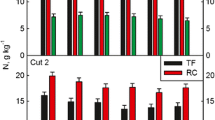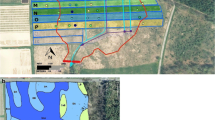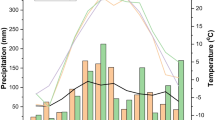Abstract
Switchgrass (Panicum virgatum L.), tall fescue [Lolium arundinaceum (Schreb.)], and reed canarygrass (Phalaris arundinacea L.) are known for high biomass productivity and for various traits that make these species more suitable for marginal environmental growing conditions. The goal of this study was to evaluate the impact of organic vs. inorganic fertilizer application on grass biomass production and soil nutrient status. Switchgrass, tall fescue, and reed canarygrass were established on a sandy soil and a clay soil at the Cornell University Willsboro Research Farm in Willsboro, NY. The experiment was a split-split plot randomized block design with six replicates. Sites were whole plots, grass species were subplots, and fertility treatments were sub-subplots. The six treatments were (1) 168 kg ha−1 of N fertilizer for cool-season grasses, 84 kg ha−1 for switchgrass; (2) 56 kg ha−1 of 0-46-0 P fertilizer plus N (#1); (3) 112 kg ha−1 of 0-0-60 K fertilizer plus N (#1); (4) 89.6 Mg dairy manure ha−1; (5) 44.8 Mg dairy manure compost ha−1; and (6) no fertilizer applied (control plots). Switchgrass with a single harvest per season yielded on average 13.0 Mg ha−1, while tall fescue and reed canarygrass averaged 8.4 and 7.7 Mg ha−1, respectively, under two-cut systems. Switchgrass with no fertilization produced 84% of maximum yield of fertilized treatments. Application of a similar amount of organic N with fresh and composted dairy manure resulted in greater yields for fresh dairy manure. Organic fertilizers strongly impacted the P and K status of soils. Switchgrass is capable of high yields in marginal environments and can provide a land base for environmentally acceptable application of animal manure, although from a yield standpoint it is not very responsive to fertilizer applications.






Similar content being viewed by others
Abbreviations
- N:
-
Nitrogen
- P:
-
Phosphorus
- K:
-
Potassium
- Ca:
-
Calcium
- Mg:
-
Magnesium
- Cl:
-
Chloride
- TF:
-
Tall fescue
- RC:
-
Reed canarygrass
- SW:
-
Switchgrass
- OM:
-
Organic matter
- IN:
-
Inflorescence
- LB:
-
Leaf blade
- LS:
-
Leaf sheath
- ST:
-
Stem
References
Jannasch, R, Samson, R, de Maio, A, Adams, T, Ho Lem, C (2001) Changing the energy climate: clean and green heat from grass biofuel pellets. Climate Change 2: Canadian Technology Development Conference, 3–5 Oct, 2001, Canadian nuclear society, Toronto, Canada, Online. http://reap-canada.com/online_library/ghg_offsets_policy/10%20Changing%20the.pdf
Stoof CR, Richards BK, Woodbury PB, Fabio ES, Brumbach A, Cherney JH, Das S, Geohring L, Hansen J, Hornesky J, Mayton H, Mason C, Ruestow G, Smart LB, Volk TA, Steenhuis TS (2015) Untapped potential: opportunities and challenges for sustainable bioenergy production from marginal lands in New York and the Northeast USA. BioEnergy Res 8:482–501
Mitchell RB, Schmer MR, Anderson WF, ** V, Balkcom KS, Kiniry J, Coffin A, White P (2016) Dedicated energy crops and crop residues for bioenergy feedstocks in the central and eastern USA. Bioenerg Res 9:384–398
Casler MD, Sosa S, Hoffman L, Mayton H, Ernst C, Adler P, Boe AR, Bonos SA (2017) Biomass yield of switchgrass cultivars under high- vs. low-input conditions. Crop Sci 57:821–832
Richards BK, Stoof CR, Cary IJ, Woodbury PB (2014) Reporting on marginal lands for bioenergy feedstock production: a modest proposal. Bioenerg Res 7:1060–1062
Soldatos P (2015) Economic aspects of bioenergy production from perennial grasses in marginal lands of south Europe. Bioenerg Res 8:1562–1573
Casler MD, Cherney JH, Brummer EC (2009) Biomass yield of naturalized populations and cultivars of reed canary grass. Bioenerg Res 2:165–173
Cherney DJR, Cherney JH, Mikhailova EA (2002) Orchardgrass and tall fescue utilization of nitrogen from dairy manure and commercial fertilizer. Agron J 94:405–412
Lee DK, Owens VN, Doolittle JJ (2007) Switchgrass and soil carbon sequestration response to ammonium nitrate, manure and harvest frequency on conservation reserve program land. Agron J 99:462–468
Bandel VA, Fox RH (1984) Management of nitrogen in New England and Middle Atlantic states. In: Hauck RD (ed) Nitrogen in crop production. ASA, CSSA, and SSSA, Madison, WI, USA, pp 677–689
Mikhailova EA, Cherney JH, Cherney DJR (2003) Impact of phosphorus from dairy manure and commercial fertilizer on perennial grass forage production. J Agron Crop Sci 189:367–475
Cherney, JH, Ketterings, Q, Davis, M, Cherney, DJR (2010b) Split application of nitrogen vs. dairy manure on temperate perennial grasses. Forage and Grazinglands, doi: https://doi.org/10.1094/FG-2010-0215-01-RS
Bow JR, Muir JP, Weindorf DC, Rosiere RE, Butler TJ (2008) Integration of cool-season annual legumes and dairy manure compost with switchgrass. Crop Sci 48:1621–1628
Butler TJ, Muir JP (2006) Dairy manure compost improves soil and increases tall wheatgrass yield. Agron J 98:1090–1096
Cherney JH, Ketterings Q, Cherney DJR (2016) Soil contamination of grass biomass hay: measurements and implications. Bioenerg Res 9:773–781
USDA (2017) National Commodity Crop Productivity Index v2. USDA, NRCS, National Soil Survey Center, Federal Building, 100 Centennial Mall North, Lincoln, NE, USA, online. https://websoilsurvey.nrcs.usda.gov/app
Dietzel K, Ketterings QM, Rao R (2009) Predictors of lime needs for pH and aluminum management of New York agricultural soils. Soil Sci Soc Am J 74(2):443–448
Morgan MF (1941) Chemical soil diagnosis by the Universal Soil Testing System. Connecticut Agric Exp Sta Bull 450
NEC1012 (2011) Recommended soil testing procedures for the northeastern United States. Northeast Regional Publication No. 493, 3rd ed., Northeast Coordinating Committee for Soil Testing, Online. http://extension.udel.edu/lawngarden/soil-health-composting/recommended-soil-testing-procedures-for-the-northeastern-united-states/
Wolf A, Watson M, Wolf N (2003) Digestion and dissolution methods for P, K Ca, Mg and trace elements. In: Peters J (ed) Recommended methods of manure analysis, University of Wisconsin Ext. Publ, vol A3769, pp 30–39 http://www.soils.wisc.edu/extension/pubs/A3769.pdf
Association of Official Analytical Chemists (1990) Official methods of analysis, 15th edn. AOAC, Arlington
Cantliffe DJ, MacDonald GE, Peck NH (1970) The potentiometric determination of nitrate and chloride in plant tissue. New York’s food and life sciences bulletin no. 3. Cornell University, Ithaca, NY, USA
Little RC, Milliken GA, Stroup WW, Russell RD (1996) SAS System for mixed models. SAS Institute, Cary, NC, USA
Madoff FR, Van Es H (2000) Building soils for better crops. 2nd ed. Book 4 of the sustainable agriculture network series. Sustainable Agricultural Network, Beltsville, MD, USA 229 pp
Cherney JH, Mikhailova EA, Cherney DJR (2002) Tetany potential of orchardgrass and tall fescue as influenced by fertilization with dairy manure or commercial fertilizer. J Plant Nutr 25:1501–1525
Springer TL (2017) Effect of nitrogen fertilization and residual nitrogen on biomass yield of switchgrass. Bioenerg Res. https://doi.org/10.1007/s12155-017-9827-6
Cherney DJR, Cherney JH (2005) Forage yield and quality of temperate perennial grasses as influenced by stubble height. Forage and Grazinglands. https://doi.org/10.1094/FG-2005-0215-01-RS
Acknowledgements
The authors thank Delvin Meseck and Adam Sayward for assistance with harvesting and plot maintenance. This work was supported by the United States Department of Agriculture (USDA) National Institute of Food and Agriculture, Multistate project 218756. Any opinions, findings, conclusions, or recommendations expressed in this publication are those of the authors and do not necessarily reflect the view of the National Institute of Food and Agriculture (NIFA) or the USDA.
Author information
Authors and Affiliations
Corresponding author
Rights and permissions
About this article
Cite this article
Cherney, J.H., Ketterings, Q.M., Davis, M. et al. Management of Warm- and Cool-Season Grasses for Biomass on Marginal Lands: I. Yield and Soil Fertility Status. Bioenerg. Res. 10, 959–968 (2017). https://doi.org/10.1007/s12155-017-9869-9
Published:
Issue Date:
DOI: https://doi.org/10.1007/s12155-017-9869-9




